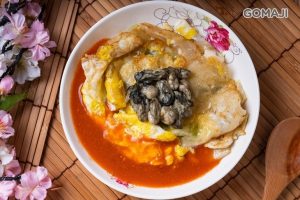Oyster omelette



The oyster omelette, as known as o-a-tsian (Chinese: 蚵仔煎; Pe̍h-ōe-jī: ô-á-chian), o-chien (Chinese: 蚵煎; Pe̍h-ōe-jī: ô-chian) or orh luak (simplified Chinese: 蚝烙; traditional Chinese: 蠔烙; Peng’im: o5 luah4) is a dish of Hokkien and Teochew origin that is renowned for its savory flavor in its native Chaoshan and Minnan region, along with Taiwan and many parts of Southeast Asia such as the Philippines, Thailand, Malaysia and Singapore due to the influence of the Hokkien and Teochew diaspora. Variations of the dish exist in some southern regions of China.
In Thailand it was adapted to mussel omelettes, though the original oyster version can also be found. In Bangkok, notable areas for oyster omelettes include Talat Wang Lang near Siriraj Hospital; Wang Lang (Siriraj) Pier in Bangkok Noi where there are two restaurants;Yaowarat neighborhood, where there is one Michelin-Bib Gourmand restaurant with Charoen Krung neighborhood in Bang Rak, among others. In 2017, the World Street Food Congress announced that oyster omelette is one of the three most notable street food among the street foods of Thailand.
The oyster omelette is a Taiwanese “night market favorite”, and has constantly been ranked by many foreigners as the top dish from Taiwan. Its generous proportions and affordable price demonstrates the trait of night market cuisines. In the Philippines, English language menus often call the dish as “Oyster Cake”.
Ingredients
The dish consists of an omelette with a filling primarily composed of small oysters. Starch (typically sweet potato starch) is mixed into the egg batter, giving the resulting egg wrap a thicker consistency. Pork lard is often used to fry the resulting omelet. Depending on regional variations, a savory sauce may then be poured on top of the omelette for added taste.
Spicy or chili sauce mixed with lime juice is often added to provide an intense kick. Shrimp can sometimes be substituted in place of oysters; in this case, it is called shrimp omelette (蝦仁煎).


